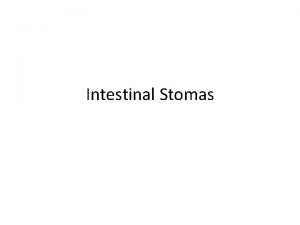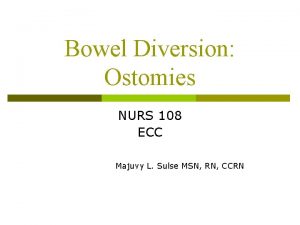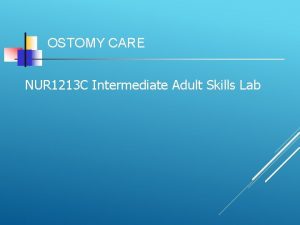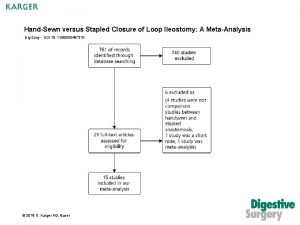Ileostomy Kaleigh Strayer Yolanda Keller Dong Liang Adriana









- Slides: 9

Ileostomy Kaleigh Strayer, Yolanda Keller, Dong Liang, Adriana Jones, Allison Horrell

Ileostomy ● An opening in the abdomen made during surgery, in which the end of the ileum is brought through the opening forming a stoma ○ ● The stoma is the lining of the small intestine ○ ○ ● Removal of part of or the whole colon and rectum can occur Allowing for the waste to now exit the body through the stoma ■ The drainage is collected in a pouch attached to the site of the stoma personally fitted to each individual Ileostomy is performed for many different reasons such as ulcerative colitis and Crohn's disease ○ ● The stoma will likely shrink some shortly after surgery ■ Should remain pink, moist and round to oval in shape Some stomas way protrude out a little, while others lie flush to the skin During the surgery a colectomy often occurs ○ ○ ● Usually on the lower right side of the abdomen Some may be for a short period of time while others are for life long use Ileostomy video

Diagnostic Labs and Procedures ● Blood test ● Chest Xray ● ECG ● Colonoscopy ● Consult with certified wound, ostomy, continence nurse (recommendations on best locations of ostomy

Preparation for Procedure ● ● ● Physical: Physical assessment (blood work/lab values), NPO after midnight, bowel prep, x-rays or ct scan, full list of current medications, discontinue blood thinners 5 days prior to surgery, medical history, any smoking or drinking, chlorhexidine (a special type of soap you will be given at your pre op visit) shower the night prior and the morning of surgery, The area to be operated on will typically be clipped of any hair the morning of surgery. Emotional: Educate patient on what to expect after surgery, Address any specific needs or concerns the patient might have, help patient with body image. Spiritual: Address any spiritual needs or cultural preferences patient might have, refer to pastoral services if patient desires the services. Legal/Consent: Informed consent following the physician explaining the procedure, POA, advance plan of care. Ethical: Advocate for patient, provide respect for autonomy

Complications of Procedure ● ● ● ● Reactions to medicines Respiratory distress Bleeding, blood clots Infection Bleeding inside your belly Damage to nearby organs Dehydration Difficulty absorbing needed nutrients from food Infection, including in the lungs, urinary tract, or belly Poor healing of the wound in your perineum (if your rectum was removed) Scar tissue in your belly that causes a blockage of the small intestine Wound breaks open Stomal ischemia/necrosis Intestinal obstruction

Complications of NOT Having an Ileostomy Complications from: ● ● ● Rectal or colon cancer metastasizing Crohn’s disease Ulcerative colitis Bowel obstruction Injury

Patient Education ● ● ● ● ● After your surgery, you will wear an odor-proof pouching system over your ostomy the pouch attaches to your abdomen by the skin barrier and is fitted over and around your stoma to collect your bowel movements and gas It may be essential to buy a fitted waterproof mattress cover, bed pads, or cloth underpads to place over the mattress and bed sheets Empty your pouch when it’s almost halfway full you should change your pouching system every 3 to 5 days If (if you have leakage, change it immediately) Drink 8 to 10 (8 -ounce) glasses of liquids a day. Limit your intake of caffeine and alcohol. They can dehydrate you Limit foods high in fiber and high in simple sugars Don’t do sit-ups, push ups, or any strenuous exercise for 2 to 3 months after your surgery Call the doctor if you: Vomit, haven’t had a bowel movement for 3 to 6 hours, develop abdominal pain or symptoms of dehydration, increased thirst, dry mouth, loss of appetite, decreased urine output, weakness, muscle, abdominal, or leg cramps, feeling faint, more bowel movements than usual, and increased frequency of emptying the pouch

Post Procedure Care ● ● ● ● ● Apply an ostomy pouch over the stoma; healthy stoma is red in color. Evaluate stoma output. Stool from an ileostomy is liquid. Assess frequently for bleeding, stoma viability, and function. In the early postoperative period, small amounts of blood in the pouch are expected. Monitor stoma color. A dark blue, purple, or black stoma indicates compromised circulation, requiring HCP notification. Postoperative drainage will be dark green and progress to yellow as the client begins to eat. Assess the peristomal skin. Skin around the stoma should remain clean and pink and free of irritation, rashes, inflammation, or excoriation. Apply skin barriers and creams (adhesive paste) to peristomal skin and allow to dry before applying a new appliance. Risk for dehydration and electrolyte imbalance exists. Empty the ostomy bag when it is one-fourth to one-half full of drainage. Evaluate ability of the client or support person to perform ostomy care.

References American College of Surgeons. (n. d. ) Your Colostomy or Ileostomy. https: //www. facs. org/education/patient-education/skills-programs/ostomy-program/adult-skills-kits/colostomy-ileostomy-contents/yourcolostomy-or-ileostomy Assessment Technologies Institute. (2016). RN Adult Medical Surgical Nursing (10 th ed. ). Leewood, KS: Assessment Technologies Institute. Cancer. org. (n. d. )Treatments and Side Effects. From https: //www. cancer. org/treatments-and-side-effects/physical-side-effects/ostomies/ileostomy. html Cancer. org. (n. d. ) What is an Ileostomy? From https: //www. cancer. org/treatments-and-side-effects/physical-side-effects/ostomies/ileostomy/what-is-ileostomy. html Ignatavicius, D. D. , Workman, M. L. , La. Charity, L. A. , Kumagai, C. K. , & Ignatavicius, D. D. (2016). Clinical nursing judgment study guide for Medical-surgical nursing, eighth edition: patient-centered collaborative care. Philadelphia: Elsevier. Le. More, P. , Burke. K. , & Dwyer. T. (2015). Medical-surgical nursing (2 nd ed. ). Pearson Higher Education AU. Mskcc. org. (2017). Caring for Your Ileostomy or Colostomy | Memorial Sloan Kettering Cancer Center. Retrieved October 15 th, 2017 from https: //www. mskcc. org/cancer-care/patient-education/caring-foryour-ileostomy-colostomy#learning-to-care-for-your-ostomy Patient Education. (2017). Patient Education. Retrieved October 12 th, 2017, from http: //www. augusta. edu/mcg/surgery/midds/patient_education/index. php Silvestri, L. A. , & Silvestri, A. E. (2017). Saunders comprehensive review for the NCLEX-RN examination (7 th ed. ). . St. Louis, MO: Elsevier.
















